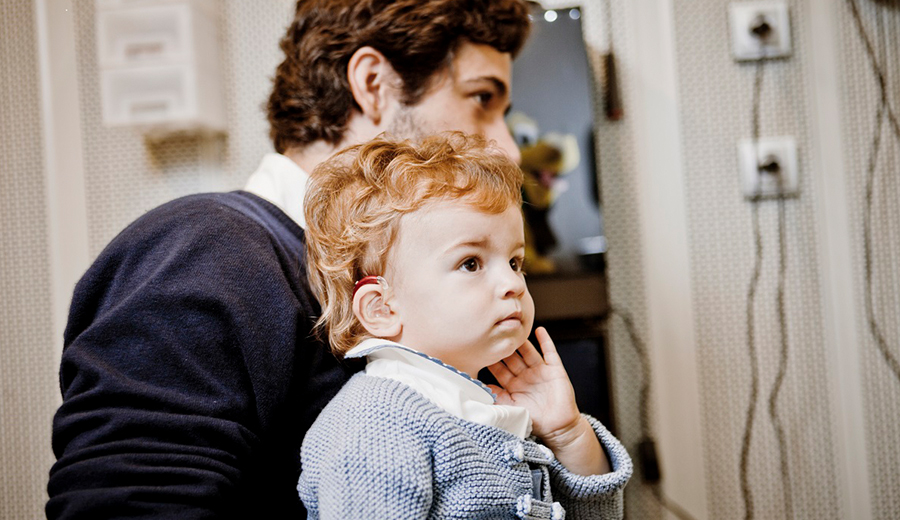Written By: Melody Bertrand
As a new parent, the joy, excitement and euphoria of a new baby cannot be described in words. From the first cry to the first touch, these firsts are printed on your hearts as your new baby makes his or her way into your lives.
Before leaving the hospital, your baby receives a range of screenings and checks to ensure he or she is healthy and ready to go home. One of these screenings is a newborn hearing screening.
In 2010, Early Hearing Detection and Intervention (EHDI) legislation mandated that all newborns receive a hearing screen before leaving the hospital. The goal is to detect hearing loss as early as possible. This is not a comprehensive exam but a quick screening to see if a hearing loss might be present.
Why is that important? As cited by the National Institute on Deafness and Other Communication Disorders, about two-three of every 1,000 children born in the United States are born with a detectable level of hearing loss in one or both ears. Further, more than 90 percent of those children are born to parents with typical hearing.
Access to Sound in the First Weeks of Life
Beginning at just 18 to 20 weeks gestation, sounds are heard and play a critical role in brain development. From the moment a baby is born, he or she responds to voices and noises, particularly the mother’s voice and others heard regularly while in the womb. A child with hearing loss cannot receive the same exposure to sound, and so immediate intervention with amplification (e.g., hearing aids) is needed to provide access to speech and other sounds.
Babies can receive a comprehensive hearing evaluation by a qualified pediatric audiologist, hearing aids and other interventions post-birth. The state EHDI program in the state or territory near you can provide a list of qualified local pediatric audiologists.
Why are early identification and intervention so important? The human brain is programmed to learn language during the first six years of life – with the first three-and-a-half years being the most critical. Without intervention, it becomes increasingly difficult to acquire language as a child matures. When infants who are deaf or hard of hearing receive timely and appropriate diagnostic and intervention services, they maintain positive language and communication outcomes.
New Changes: 1-3-6 to 1-2-3
In the U.S., newborn hearing screening and follow-up, including early intervention (EI), (for those children identified as having hearing loss and deemed eligible for EI services), are addressed through state EHDI programs. These programs also partner with the state’s Lead Agency for EI to ensure that babies and their families receive follow-up and services.
States currently follow a “1-3-6 Model,” which is a timeline to identify a hearing loss by 1 month, diagnose by 3 months, and enroll in an EI program by 6 months. In October 2019, the Joint Committee for Infant Hearing updated its guidelines:
“To provide appropriate access to language stimulation and intervention services as soon as possible, EHDI programs meeting current targets might consider setting a new target of 1-2-3 months (screening completed by 1 month of age, audiologic diagnosis completed by 2 months of age, and early intervention initiated no later than 3 months of age)” (p. 5).
Considering the 1-2-3 Challenge
By 1 month of age, the newborn screening should be completed. For most babies, this occurs at the hospital right after birth. If a baby fails the newborn screening, further audiologic testing takes place.
By 2 months of age, a baby referred for additional testing should receive initial tests to diagnose any hearing loss. A pediatric audiologist performs these tests, who is a professional with a master’s or doctoral degree in audiology and has the technical expertise to work with infants and children.
The audiologist performs a series of tests to determine if a hearing loss exists and, if so, the type (which part of the auditory system is affected), degree (degree of hearing loss) and configuration (frequencies or pitches affected) of the hearing loss. Tests for infants and children are non-invasive and painless. The Alexander Graham Bell Association for the Deaf and Hard of Hearing offers an overview of these tests.
By 3 months of age, the baby should be enrolled in an EI program if a hearing loss is confirmed, which means parents must receive information and resources to make decisions about choosing a communication option and EI programs.
These decisions are crucial to your child’s lifelong development. As parents, it will be your job to make the decision that is in your child’s and family’s best interest when it comes to communication options.
What are these options? Various means of communication options exist: Listening and Spoken Language, Cued Speech, Total Communication, or Signed Language. What is important is that you research the different options available and, most notably, their outcomes. AG Bell provides a great overview of these options as well as other resources to help guide you through the early diagnosis and intervention process.
By receiving a timely diagnosis and intervening early, you will increase your child’s ability to communicate, develop to levels on par with their peers, pursue a dream career, and live a life without limits.
So, if you are a parent in need of guidance for your newborn child, please reach out. We’re here Monday through Friday to lend support. Call 1-833-LSL-LINK (1-800-575-5465) or email [email protected]. For more information on the Listen-Learn-Link Hotline, click here.

